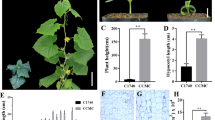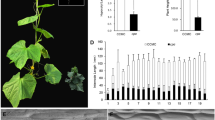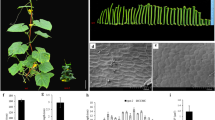Abstract
Key message
A novel dwarf cucumber mutant, scp-2, displays a typical BR biosynthesis-deficient phenotype, which is due to a mutation in CsDET2 for a steroid 5-alpha-reductase.
Abstract
Brassinosteroids (BRs) are a group of plant hormones that play important roles in the development of plant architecture, and extreme dwarfism is a typical outcome of BR-deficiency. Most cucumber (Cucumis sativus L.) varieties have an indeterminate growth habit, and dwarfism may have its value in manipulation of plant architecture and improve production in certain production systems. In this study, we identified a spontaneous dwarf mutant, super compact-2 (scp-2), that also has dark green, wrinkle leaves. Genetic analyses indicated that scp-2 was different from two previously reported dwarf mutants: compact (cp) and super compact-1 (scp-1). Map-based cloning revealed that the mutant phenotype was due to two single nucleotide polymorphism and a single-base insertion in the CsDET2 gene that resulted in a missense mutation in a conserved amino acid and thus a truncated protein lacking the conserved catalytic domains in the predicted steroid 5α-reductase protein. Measurement of endogenous hormone levels indicated a reduced level of brassinolide (BL, a bioactive BR) in scp-2, and the mutant phenotype could be partially rescued by the application of epibrassinolide (EBR). In addition, scp-2 mutant seedlings exhibited dark-grown de-etiolation, and defects in cell elongation and vascular development. These data support that scp-2 is a BR biosynthesis-deficient mutant, and that the CsDET2 gene plays a key role in BR biosynthesis in cucumber. We also described the systemic BR responses and discussed the specific BR-related phenotypes in cucumber plants.





Similar content being viewed by others
References
Alabadí D, Gil J, Blázquez MA, García-Martínez JL (2004) Gibberellins repress photomorphogenesis in darkness. Plant Physiol 134:1050–1057
An Y, Zhou H, Zhong M, Sun J, Shu S, Shao Q, Guo S (2016) Root proteomics reveals cucumber 24-epibrassinolide responses under Ca(NO3)2 stress. Plant Cell Rep 35:1081–1101
Atsmon D (1968) The interaction of genetic, environmental, and hormonal factors in stem elongation and floral development of cucumber plants. Ann Bot 32:877–882
Bai M, Shang J, Oh E, Fan M, Bai Y, Zentella R, Sun T, Wang Z (2012) Brassinosteroid, gibberellin and phytochrome impinge on a common transcription module in Arabidopsis. Nat Cell Biol 14:810–817
Bajguz A (2011) Brassinosteroids: a class of plant hormone: brassinosteroids—occurrence and chemical structures in plants. Wiley-Interscience, New York, pp 1–27
Bishop GJ (2003) Brassinosteroid mutants of crops. J Plant Growth Regul 22:325–335
Bishop GJ, Harrison K, Jones JDG (1996) The tomato Dwarf gene isolated by heterologous transposon tagging encodes the first member of a new cytochrome P450 family. Plant Cell 8:959–969
Cavagnaro PF, Senalik DA, Yang L, Simon PW, Harkins TT, Kodira CD, Huang S, Weng Y (2010) Genome-wide characterization of simple sequence repeats in cucumber (Cucumis sativus L.). BMC Genom 11:569
Chory J, Nagpal P, Peto CA (1991) Phenotypic and genetic analysis of det2, a new mutant that affects light-regulated seedling development in Arabidopsis. Plant Cell 3:445–459
Clouse SD, Sasse JM (1998) Brassinosteroids: essential regulators of plant growth and development. Annu Rev Plant Physiol Plant Mol Biol 49:427–451
Clouse SD, Langford M, McMorris TC (1996) A brassinosteroid-insensitive mutant in Arabidopsis thaliana exhibits multiple defects in growth and development. Plant Physiol 111:671–678
Cramer CS, Wehner TC (2000) Path analysis of the correlation between fruit number and plant traits of cucumber populations. HortScience 35:708–711
Crienen J, Reuling G, Segers B, van de Wal M (2009) New cucumber plants with a compact growth habit. Patent, International publication number WO 2009/059777 A1
Fazio G, Staub JE, Stevens MR (2003) Genetic mapping and QTL analysis of horticultural traits in cucumber (Cucumis sativus L.) using recombinant inbred lines. Theor Appl Genet 107:864–874
Fu F, Mao W, Shi K, Zhou Y, Asami T, Yu J (2008) A role of brassinosteroids in early fruit development in cucumber. J Exp Bot 59:2299–2308
Fujioka S, Li J, Choi YH, Seto H, Takatsuto S, Watanabe T, Kuriyama H, Yokota T et al (1997) The Arabidopsis de-etiolated2 mutant is blocked early in brassinosteroid biosynthesis. Plant Cell 9:1951–1962
Grove MD, Spencer GF, Rohwedder WK, Mandava NB, Worley JF, Warthen JD, Steffens GL, Flippen-Anderson JL et al (1979) Brassinolide, a plant growth-promoting steroid isolated from Brassica napus pollen. Nature 281:216–217
Gudesblat GE, Russinova E (2011) Plants grow on brassinosteroids. Curr Opin Plant Biol 14:530–537
Hartwig T, Chuck GS, Fujioka S, Klempien A, Weizbauer R, Potluri DP, Choe S, Johal GS et al (2011) Brassinosteroid control of sex determination in maize. Proc Natl Acad Sci USA 108:19814–19819
Hedden P (2003) The genes of the green revolution. Trends Genet 19:5–9
Kauffman CS, Lower RL (1976) Inheritance of an extreme dwarf plant type in the cucumber. J Am Sci Hortic Sci 101:150–151
Kojima M, Kamada-Nobusada T, Komatsu H, Takei K, Kuroha T, Mizutani M, Ashikari M, Ueguchi- Tanaka M et al (2009) Highly sensitive and high-throughput analysis of plant hormones using MS-probe modification and liquid chromatography-tandem mass spectrometry: an application for hormone profiling in Oryza sativa. Plant Cell Physiol 50:1201–1214
Kubicki B, Soltysiak U, Korzeniewska A (1986) Induced mutations in cucumber (Cucumis sativus L.) V. Compact type of growth. Genet Pol 27:289–298
Levinson G, Gutman GA (1987) Slipped-strand mispairing: a major mechanism for DNA sequence evolution. Mol Bio Evol 4:203–221
Li J, Nagpal P, Vitart V, McMorris TC, Chory J (1996) A role for brassinosteroids in light-dependent development of Arabidopsis. Science 272:398–401
Li Z, Pan J, Guan Y, Tao Q, He H, Si L, Cai R (2008) Development and fine mapping of three co-dominant SCAR markers linked to the M/m gene in the cucumber plant (Cucumis sativus L.). Theor Appl Genet 117:1253–1260
Li Y, Yang L, Pathak M, Li D, He X, Weng Y (2011) Fine genetic mapping of cp: a recessive gene for compact (dwarf) plant architecture in cucumber, Cucumis sativus L. Theor Appl Genet 123:973–983
Li Z, Wang S, Tao Q, Pan J, Si L, Gong Z, Cai R (2012) A putative positive feedback regulation mechanism in CsACS2 expression suggests a modified model for sex determination in cucumber (Cucumis sativus L.). J Exp Bot 63:4475–4484
Li P, Chen L, Zhou Y, Xia X, Shi K, Chen Z, Yu J (2013) Brassinosteroids-induced systemic stress tolerance was associated with increased transcripts of several defence-related genes in the phloem in Cucumis sativus. PLoS One 8:e66582
Lin T, Wang S, Zhong Y, Gao D, Cui Q, Chen H, Zhang Z, Shen H et al (2016) A truncated F-box protein confers the dwarfism in cucumber. J Genet Genom 43:223–226
Michelmore RW, Paran I, Kesseli RV (1991) Identification of markers linked to disease-resistance genes by bulked segregant analysis: a rapid method to detect markers in specific genomic regions by using segregating populations. Proc Natl Acad Sci USA 88:9828–9832
Niemirowicz-Szczytt K, Rucinska M, Korzeniewsia A (1996) An induced mutation in cucumber (Cucumis sativus L.): super compact. Cucurbit Genet Coop Rep 19:1–3 (article 1)
Noguchi T, Fujioka S, Takatsuto S, Sakurai A, Yoshida S, Li J, Chory J (1999) Arabidopsis det2 is defective in the conversion of (24R)-24-methylcholest-4-en-3-one to (24R)-24-methy-5α-cholestan-3-one in brassinosteroid biosynthesis. Plant Physiol 120:833–839
Nomura T, Jager CE, Kitasaka Y, Takeuchi K, Fukami M, Yoneyama K, Matsushita Y, Nyunoya H et al (2004) Brassinosteroid deficiency due to truncated steroid 5α-reductase causes dwarfism in the lk mutant of pea. Plant Physiol 135:2220–2229
Peng J, Richards DE, Hartley NM, Murphy GP, Devos KM, Flintham JE, Beales J, Fish LJ et al (1999) ‘Green revolution’ genes encode mutant gibberellin response modulators. Nature 400:256–261
Russell DE, Wilson JD (1994) Steroid 5 α-reductase: two genes/two enzymes. Annu Rev Biochem 63:25–61
Shimada Y, Goda H, Nakamura A, Takatsuto S, Fujioka S, Yoshida S (2003) Organ-specific expression of brassinosteroid-biosynthetic gene and distribution of endogenous brassinosteroids in Arabidopsis. Plant Physiol 131:287–297
Steber CM, McCourt P (2001) A role for brassinosteroids in germination in Arabidopsis. Plant Physiol 125:763–769
Suzuki Y, Saso K, Fujioka S, Yoshida S, Nitasaka E, Nagata S, Nagasawa H, Takatsuto S et al (2003) A dwarf mutant strain of Pharbitis nil, Uzukobito (kobito), has defective brassinosteroid biosynthesis. Plant J 36:401–410
Symons GM, Reid JB (2004) Brassinosteroids do not undergo long-distance transport in pea. Implications for the regulation of endogenous brassinosteroid levels. Plant Physiol 135:2196–2206
Symons GM, Schultz L, Kerckhoffs LH, Davies NW, Gregory D, Reid JB (2002) Uncoupling brassinosteroid levels and de-etiolation in pea. Physiol Plant 115:311–319
Tamura K, Peterson D, Peterson N, Stecher G, Nei M, Kumar S (2011) MEGA5: molecular evolutionary genetics analysis using maximum likelihood evolutionary distance, and maximum parsimony methods. Mol Biol Evol 28:2731–2739
Tan J, Tao Q, Niu H, Zhang Z, Li D, Gong Z, Weng Y, Li Z (2015) A novel allele of monoecious (m) locus is responsible for elongated fruit shape and perfect flowers in cucumber (Cucumis sativus L.). Theor Appl Genet 128:2483–2493
Wang L, Wang Z, Xu Y, Joo SH, Lim SK, Xue Z, Xu Z, Wang Z et al (2009) OsGSR1 is involved in crosstalk between gibberellins and brassinosteroids in rice. Plant J 57:498–510
Wang B, Li Y, Zhang W (2012) Brassinosteroids are involved in response of cucumber (Cucumis sativus) to iron deficiency. Ann Bot 110:681–688
Wang H, Li W, Qin Y, Pan Y, Wang X, Weng Y, Chen P, Li Y (2017) The cytochrome P450 gene CsCYP85A1 is a putative candidate for super compact-1 (scp-1) plant architecture mutation in cucumber (Cucumis sativus L.). Front Plant Sci 8:266
Wei L, Deng X, Zhu T, Zheng T, Li P, Wu J, Zhang D, Lin H (2015) Ethylene involved in brassinosteroids induced alternative respiratory pathway in cucumber (Cucumis sativus L.) seedlings response to abiotic stress. Front Plant Sci 6:982
Wu Q, Wu D, Shen Z, Duan C, Guan Y (2013) Quantification of endogenous brassinosteroids in plant by on-line two-dimensional microscale solid phase extraction-on column derivatization coupled with high performance liquid chromatography-tandem mass spectrometry. J Chromatogr A 1297:56–63
Xia X, Zhou Y, Ding J, Shi K, Asami T, Chen Z, Yu J (2011) Induction of systemic stress tolerance by brassinosteroid in Cucumis sativus. New Phytol 191:706–720
Yang L, Koo D-H, Li Y, Zhang X, Luan F, Havey MJ, Jiang J, Weng Y (2012) Chromosome rearrangements during domestication of cucumber as revealed by high-density genetic mapping and draft genome assembly. Plant J 71:895–906
Ye Q, Zhu W, Li L, Zhang S, Yin Y, Ma H, Wang X (2010) Brassinosteroids control male fertility by regulating the expression of key genes involved in Arabidopsis anther and pollen development. Proc Natl Acad Sci USA 107:6100–6105
Acknowledgements
The authors thank Kristin Haider (USDA-ARS) for technical help and Professor Xiaofeng Wang (Northwest A&F University) for valuable suggestions on BR-related analysis. ZL and SL’s work in the University of Wisconsin at Madison visit was partially supported by the China Scholarship Council. This work was supported by the National Natural Science Foundation of China (Nos. 31471879, 31672150) (to ZL), the Innovation of Agricultural Science and Technology in Shaanxi Province (No. 2015NY081) (to ZL), the Young Talent Cultivation Project (Northwest A&F University) (to ZL) and the Agriculture and Food Research Initiative Competitive Grant 2013-67013-21105 from the U.S. Department of Agriculture National Institute of Food (to YW).
Author information
Authors and Affiliations
Corresponding authors
Ethics declarations
Conflict of interest
The authors declare that they have no conflict of interest.
Additional information
Communicated by Sanwen Huang.
Electronic supplementary material
Below is the link to the electronic supplementary material.
Rights and permissions
About this article
Cite this article
Hou, S., Niu, H., Tao, Q. et al. A mutant in the CsDET2 gene leads to a systemic brassinosteriod deficiency and super compact phenotype in cucumber (Cucumis sativus L.). Theor Appl Genet 130, 1693–1703 (2017). https://doi.org/10.1007/s00122-017-2919-z
Received:
Accepted:
Published:
Issue Date:
DOI: https://doi.org/10.1007/s00122-017-2919-z




